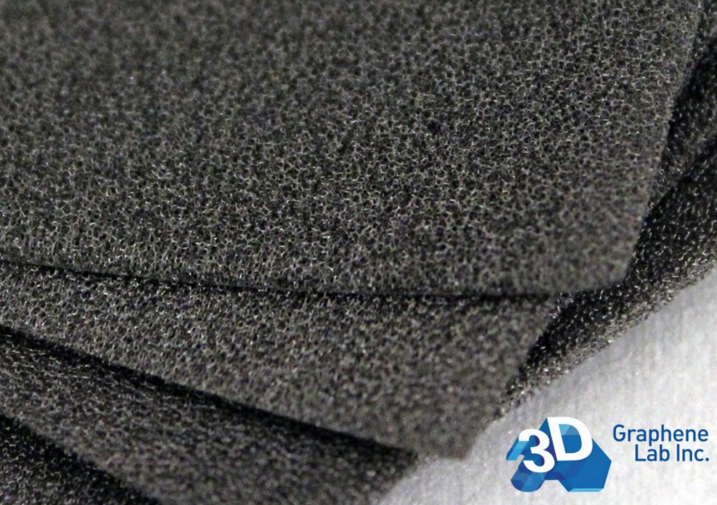
3 More Reasons Graphene is a Smart Investment: Ultrasonic Microphones, Bendy Phones, and the World’s Best Fishing Rod
Graphene has already proved that it’s worth more than its weight in gold with huge innovations in solar power, medical treatments, and a whole lot more. So it comes as no surprise that graphene investments have heated up as a result, with KIC InnoEnergy recently investing over $4 million USD in leading European ultracapacitor manufacturer Skeleton Technologies. Additionally, Graphene 3D Lab Inc. recently signed a research and development agreement with a Fortune 500 company, proving that we’re getting closer to the consumer market phase of graphene’s applications.
Here are three amazing new graphene applications we can look forward to seeing on the market in the near future. Consider it further proof that there couldn’t be a better time to invest in this wonder material.
1. Ultrasonic Microphones
Graphene is the star of the show in the recent development of a microphone 32 times as sensitive as those currently on the market. A research team shared their work in a paper with science journal 2D Materials. One of the paper’s authors, Marko Spasenovic, said, “Given its light weight, high mechanical strength and flexibility, graphene just begs to be used as an acoustic membrane material.”
Microphones typically work like megaphones in reverse: they turn sound into electrical currents. As sound waves pass through a membrane that vibrates and causes a metallic coil to to move back and forth across a magnet, sending the electric current to amplifiers. Nickel is the normal material used to make microphone membranes, but this research team applied graphene to the membranes through a chemical vapor deposition (CVD) process. Across a wide range of amplitudes, the graphene microphone was found to have an amazingly superior ability to detect more nuanced sound than nickel predecessors. While this technology is still being developed for commercial applications, graphene is poised to revolutionize the music industry with this breakthrough.
2. Bendable Smartphones
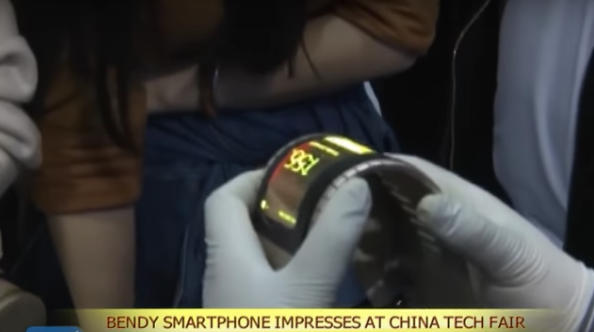
The application of graphene to flexible tech displays has been in the works for a while now, but just this month, the world got its first glimpse of a functional flexible smartphone at a trade show at Nanping International Conventional Center in Chongqing, China. While details have been kept under wraps on the company and its breakthrough technology, we know that the screen gets its impressive flexibility through the use of graphene.
At just one atom thick, graphene’s huge appeal for tech applications comes in its outsized strength, flexibility, thinness, and ability to conduct heat and electricity. In a video from the trade show, we see these properties in action as the smartphone can literally wrap around a wearer’s wrist with a highly responsive touch screen. As companies race to create the first market-ready bendable smartphone, graphene is about to get even hotter as an investment opportunity.
3. Supercharged Fishing Rod
When a world-class fisherman and a former NASA engineer team up to build a better fishing rod, you know the results are going to be impressive. 200 times stronger than steel, graphene was a natural choice for a major upgrade to sport fisher’s main tool. Pro angler Scott Mackenzie teamed up with Gary Savage, who has not only worked on NASA space shields, but also on Formula One racecars. “We have taken the best of everything we have learned in Formula One to create the best fly rod ever made,” said Savage to Tech Times. To create the rod, honeycombed graphene was rolled into tiny tiny tubes, which transform into bonded threads that enable the rod to be super strong while also remaining flexible.
Graphene can stretch up to 20 percent of its length, and is 30 times stronger than Kevlar, making it a win-win for the unique requirements of fishing. From flexing deeply upon casting the line to retaining its strength when reeling in a catch, this is a huge fishing breakthrough that the team believes will revolutionize the sport of salmon fishing. This is not the first time that graphene has been used to revolutionize sports equipment, which is a nascent market with huge potential for innovation.

Graphene Revolutionizes Solar Power
Among scientists, investors and tech enthusiasts, the hype surrounding graphene shows no signs of stopping. Graphene’s latest application proves yet another way the wonder material could change the world, this time by revolutionizing how we produce and store solar energy.
During the last few decades, solar panels have grown increasingly efficient, but the technology still requires sunlight. Like a baseball game, solar power generation cannot occur without the cooperation of the weather. Or can it?
A team of scientists in Qingdao, China are exploiting graphene’s conductivity to develop a new kind of prototype solar cell. While solar technology that currently exists harnesses energy from the sun, the Chinese scientists’ prototype generates power from an unlikely source: raindrops.
The idea of solar power ‘running’ on rain seems counterintuitive, to say the least. The scientists’ study was actually inspired by previous research they conducted, which demonstrated that electricity can be produced by exposing graphene to salt water. Employing a similar concept in the development of their prototype, the research team applied a coat of liquified graphene to solar cells.
So, where do raindrops fit in? And how do they provide electrical power? On a technical level, precipitation and graphene are an ideal electricity-producing pair. Because raindrops contain positively charged ions — salts like sodium, calcium, and ammonium– rainwater adhered to the graphene surface that was coated onto the solar cells. Along with the electrons, the raindrops from the graphene surface stacked to form two layers. The potential energy difference between the two layers was strong enough to produce voltage and an electrical current. Graphene is extremely conductive, which also helped.
Over the last few decades, solar panels have become increasingly efficient, but they still require an ample supply of sunlight to function. In the not so distant future, Graphene could change that. As Qunwei Tang, the materials scientist who heads the research team in Qingdao, says, “Future solar cells may produce electricity in all weather.” Eliminating solar technology’s reliance on sunlight opens up a lot of possibilities, to say the least.
Solar panels that are capable of working without sunlight—no matter the weather or geographical location—would curtail our reliance on fossil fuels and reduce environmental pollution. If rain could be used as a source of energy, the use of solar power would certainly skyrocket. Moreover, in areas of the world that experience an extended rainy season, accessing this kind of solar power would facilitate development and improvement in the overall quality of life for people who live in those regions.
The Chinese researchers will need to refine their prototype’s design before creating a model that can be put to practical use. It’s unlikely that people will be powering their homes with rain anytime soon. All the same, if and/or when solar technology of this kind does become commercially available, the implications will be tremendous.

Can Graphene Nanobots Clean Up the Ocean?
It is estimated that by 2050 there will be more plastic waste than fish in the world’s oceans. Even worse, the prevalence of waste metals such as cadmium and lead in the water pose a threat not only to fish, but also to the survival of all species that eat seafood, humans included. Clearly it’s paramount that we find a way to reverse this tidal wave of pollution.
While scientists have been testing viable options for cleaning the rampant pollution from our oceans for years, a recent breakthrough has led to a promising new solution in the form of graphene robots. While it sounds like science fiction to conjure up a swarm of graphene coated nanobots capable of cleaning lead from wastewater, that’s just what an international team of scientists have recently done.
According to a paper published in the journal Nano Letters, these revolutionary nanobots have three key features:
- A graphene oxide exterior to absorb lead or other heavy metals.
- A nickel core that allows scientists to control the nanobots movement via magnetic field.
- Inner platinum coating that reacts with hydrogen peroxide to create an “engine” that self-propels the bots forward through the water.
Research found that a swarm of hundreds of thousands of microbots could remove 95% of toxic lead present in a body of water in just one hour. Even more impressive, these microscopic bots—smaller than a single strand of hair—can be reused after being stripped of the collected lead ions through an acidic bath. Further testing will focus on expanding their hoovering abilities to additional metal pollutants.
Describing his team’s exciting findings to Phys.org, Samuel Sánchez, a scientist at the Max-Planck Institute for Intelligent Systems in Stuttgart, Germany, had this to say:
“This is a new application of smart nanodevices for environmental applications. The use of self-powered nanomachines that can capture heavy metals from contaminated solutions, transport them to desired places and even release them for ‘closing the loop’—that is a proof-of-concept towards industrial applications.”
These self-propelled layered robots have potentially amazing applications that go far beyond the aquatic. Imagine bots being used for successful drug delivery and biosensing. This is not the first time graphene has been applied in ways that will revolutionize medicine, or in helping to clean the environment. Cleaning the ocean just proves that there really is nothing that graphene can’t seem to do, making it a great nanomaterial to add to your investment portfolio.

Graphene’s Latest Flexible Sheet Application Mimics Moth Vision
The scientific community continues to tout graphene’s amazing properties, and one of its most recent promising applications takes its inspiration from an unlikely source: moths. Before we get into what graphene could possibly have to do with this unassuming insect, let’s review the properties that make graphene such a promising material to invest in:
Like something straight out of a comic book, graphene’s properties are unheard of among current materials on the market. This wonder material is 200 times stronger than steel and able to conduct electricity 1000 times faster than copper. As if that’s not impressive enough, graphene is also flexible, stretchy, and transparent. Oh, and it’s a million times thinner than a single strand of hair.
Graphene clearly proves that good things come in small packages. The material’s extreme thinness, however, has presented researchers with a unique set of challenges as well as opportunities. The thin flat material will be critical in medical and electronic applications.However, graphene has proven inefficient at absorbing light, which has delayed the progress of potential optical applications.
All that’s about to change. New research out of the University of Surrey has demonstrated how graphene can be boosted to absorb 90 percent more incident light, rendering graphene the most light absorbent material for its weight to date. The research appears in a new paper in Science Advances. So how did the research team, led by Professor Ravi Silva, work with graphene’s unique properties to supercharge its light absorption to such an impressive extent? Looking to nature, moths–of all creatures–inspired the research team’s solution.
“Moths’ eyes have microscopic patterning that allows them to see in the dimmest conditions. These work by channelling light towards the middle of the eye, with the added benefit of eliminating reflections, which would otherwise alert predators of their location,” explained Professor Silva. “We have used the same technique to make an amazingly thin, efficient, light-absorbent material by patterning graphene in a similar fashion,” he explained.
The team employed a technique called nanotexturing, which involves growing graphene around a textured metallic surface. By creating a texture on the graphene sheet, light can be localized into the spaces between the pattern, thereby creating a kind of “smart” lining that is able to absorb 90 percent more light.
This inspired approach could have all sorts of amazing tech applications. Here are just a few initial uses that Professor Silva noted:
- Solar cells coated with nanotextured sheets could harvest dim light
- Infrared imaging in opto-MEMs devices
- Indoor installation could yield smart wallpaper to generate electricity from light or heat that is typically wasted
- New sensors and energy harvesters for electronic devices could improve performance and efficiency
The recent developments in manipulating the way graphene absorbs light supports the notion that resources found in nature can enhance manmade substances in entirely new and unexpected ways. The natural world is valuable for many reasons, and facilitating the next frontier in cutting edge technology is a source of value that is not often cited. It’s worth remembering that along with the research team at the University of Surrey, we have moths to thank for this big breakthrough.

Graphene’s Plan to Build Better Brains
Whatever field scientists look to improve by applying graphene’s amazing principles to it, major breakthroughs soon follow. Lately the biomedical field has turned its attention to the wonder nanomaterial, and the promising results could revolutionize treatment for motor disorders, paralysis, and limb loss. It’s all about electrodes.
How can this two-dimensional form of carbon that’s thinner than a sheet of paper and stronger than diamond make such bold claims to improve the human brain? Researchers at the University of Trieste in Italy and the Cambridge Graphene Centre have demonstrated how graphene could be used to make electrodes that could safely implant in the brain to treat various medical conditions. These electrodes would interface with nerve cells without damaging the cells’ integrity. Part of graphene’s strength in medical applications is its amazing properties of conductivity, making it a natural winner for electrodes.
Successful implantation of graphene based electrodes in the brain could lead to new breakthroughs in restoring sensory function to amputee and paralysed patients, and could provide new hope for patients with chronic conditions such as Parkinson’s disease.
“For the first time we interfaced graphene to neurons directly,” said Professor Laura Ballerini of the University of Triest. “We then tested the ability of neurons to generate electrical signals known to represent brain activities, and found that the neurons retained their neuronal signalling properties unaltered. This is the first functional study of neuronal synaptic activity using uncoated graphene based materials.”
This is a huge breakthrough for electrodes, as they’ve previously been hampered by the limitations of other materials, such as tungsten or silicon. Typically these materials have been shown to lose conductivity over time, as scar tissue forms over the part of the brain where the electrode was surgically inserted. Graphene solves that problem by being highly biocompatible in research.
This is an exciting first step in revolutionizing deep brain implants. Check out the full research here, and for other exciting recent medical news on graphene, check out this post on how graphene will revolutionize the production of artificial limbs.
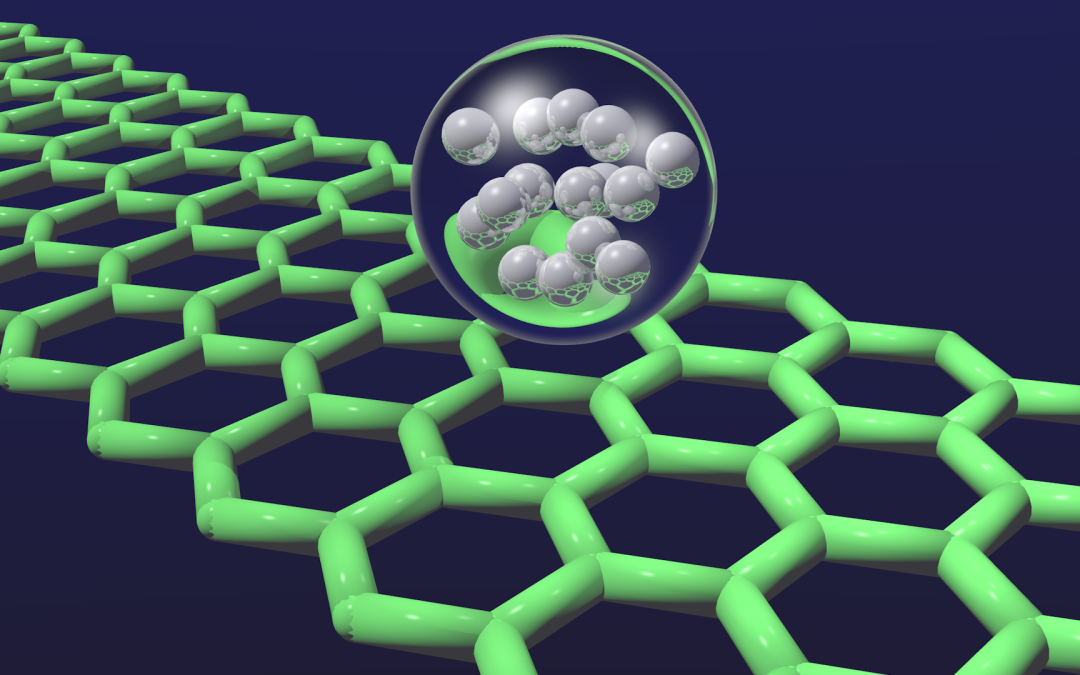
Medical Fields Poised for Revolution Thanks to Graphene
Since its discovery in 2004, graphene’s reputation as the hottest nanomaterial on the block has extended far beyond science labs. With over 25,000 patents filed for potential applications, graphene is poised to revolutionize several industries that directly affect our day to day lives.
Stronger than diamond and thinner than a sheet of paper, graphene is a single atom thick hexagonal layer of graphite. To add to its street cred, graphene can carry 1,000 times more electricity than copper, has a flexible structure that allows for strength without rigidity, and can dissipate heat like nobody’s business. Because of its unique physicochemical properties and high surface-to-volume ratio, graphene is uniquely positioned to lead the charge on a number of promising medical breakthroughs.
1. Sensitive Prosthetics
At the University of Glasgow, a research team led by Dr. Ravinder Dahiya recently found a way to cut graphene production costs by 100x, and in the process, realized that the nanomaterial could radically improve prosthetic limbs. Whereas today’s prosthetics are made of carbon fiber composites, Dr. Dahiya believes that using graphene could provide an ultra-flexible, conductive skin-like surface that could allow for sensation to be conveyed through prosthetics for the first time.
2. Faster Gene Sequencing
Successful simulations from the National Institute of Standards and Technology (NIST) have demonstrated how graphene could improve gene sequencing to make it significantly more accurate and rapid than today’s chemical process. The method involves nanopore sequencing, in which a single DNA molecule gets pulled through a tiny, chemically active hole in a super thin sheet of graphene, allowing changes in electrical current to be detected.
This method suggests that about 66 billion bases—the smallest units of genetic info—could be identified in just one second through this method. Even more impressive, the study has found the results to be 90% accurate with no false positives. If the simulation proves as effective in experiments, this could be a huge breakthrough in several fields that utilize genetic information, including forensics.
3. Banishing Bacteria
New research from the Catholic University of the Sacred Heart and the Institute for Complex Systems in Rome has found graphene oxide to be capable of decreasing infections spread from medical tools to patients. Coating medical tools with this carbon-based compound could greatly decrease the prevalence of at least three common post-surgery infections, thereby reducing the need for antibiotics. Graphene oxide has been found to have amazing antibacterial properties, effectively wrapping around the bacteria, puncturing its membrane, and ensuring that it can’t reproduce once inside the human body.
This novel method of blocking bacteria would be more environmentally-friendly than current methods, and also safer: unlike drug based antimicrobial therapy, graphene is just carbon—a building block of life—and therefore its cytotoxicity on human cells is very low. In other words, graphene is about to become the world’s smallest medical superhero, banishing microscopic bad guys that lurk on “clean” medical tools.
4. Building Better Brains
Researchers at the University of Trieste in Italy and the Cambridge Graphene Centre have demonstrated how graphene could be used to make electrodes that could be safely implanted in the brain to treat various medical conditions. These electrodes would interface with nerve cells without damaging the cells’ integrity. Central to graphene’s appeal in medical applications is its amazing properties of conductivity, making it a natural winner for electrodes.
Successful implantation of graphene based electrodes in the brain could lead to new breakthroughs in restoring sensory function to amputee and paralysed patients, and could provide new hope for patients with chronic conditions such as Parkinson’s disease. Tungsten and silicon based electrodes lose conductivity over time, as scar tissue grows over the device and alters the signal. Graphene, however, remains highly biocompatible, even with scar tissue regrowth. In other words, graphene is about to help doctor’s build better, more responsive brains.
Photo Credit: Flickr/UCL Mathematical and Physical Sciences

Graphene Could Provide a Breakthrough Diabetes Treatment
Graphene is at the forefront of yet another breakthrough in medical technology. Thanks to the thinnest-in-the-world material, people with diabetes might one day be spared a life of constant injections.
Last month, the journal Nature Nanotechnology detailed the success of a new graphene-based wrist patch that can sense changes in a diabetic person’s sweat (i.e. noticing a change in their pH level or perceiving certain body-temperature fluctuations that signal rising glucose levels). The patch’s sensor technology can be wirelessly paired with a smartphone, thereby giving the wearer an easy way to keep tabs on the highs and lows of their glucose levels.
As needed, the wrist patch will release a dose of the drug metformin through a series of microneedles much less invasive than the typical insulin delivery systems currently on the market. Graphene’s new method of regulating and reducing blood sugar levels is a huge breakthrough for patients and doctors alike.
Researchers tested the wrist patch on diabetic mice. This could be one of the reasons that Nova Next, PBS’s science and technology hub, calls the device’s capabilities “relatively limited.” Still, the advancement could mean a lot for the future of continuous glucose monitoring and management. The device’s success on mice is an important first step in developing this technology further for human patients.
It’s no surprise that graphene, with its virtual transparency and excellent ability to transmit heat, was a go-to material for the experimental skin patch. But in order for graphene to be the key player in real-time glucose monitoring, the researchers needed to give it a boost. By enhancing the graphene patch with gold in the form of a fine mesh, the research team was able to enhance the device’s electrochemical interface, allowing the stable transfer of electrical signals between the patient’s skin and the patch.
The sweat-based diabetes monitor signals a booming business that targets a rapidly increasing demographic. According to a new report from the World Health Organization, the number of people with diabetes has quadrupled to 422 million in the last 30 years. As for the number of people in the U.S. with diabetes, the CDC puts that figure at a little more than 29 million, which is nearly ten percent of the population.
Some accredit the increase in the number of diabetic patients to the rising prevalence of sedentary lifestyles. According to the American Diabetes Association, diabetes is especially prevalent among seniors. As the number of elderly individuals increases, so too will the demand for new and better glucose monitoring technology products. Experts see continuous glucose monitoring as a cost-effective measure that possibly reduces hospital stays, not to mention giving diabetic patients more control of their health.
Diabetes is a leading cause of death and disability in the United States. Market research publisher Kalorama Information released a report last year estimating that the worldwide glucose monitoring device and diabetes management market is estimated at $10,025 billion. With ever-developing technology and the strong desire for non-invasive methods for glucose monitoring, this segment of the diabetes management industry is prime for growth.
Keeping tabs on glucose levels is the foundation of diabetes management. It’s exciting to see that graphene, long heralded for its limitless potential in the wearable technology field, could one day provide a simple solution to millions of people who are living with diabetes.
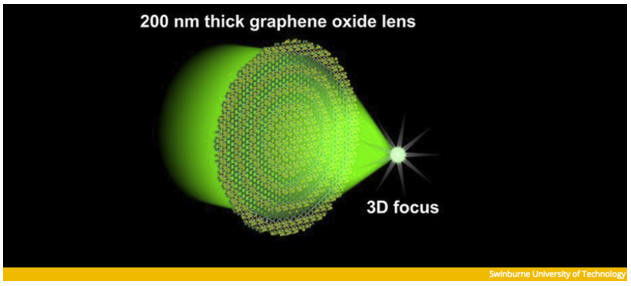
New Graphene Lens Enables Computers to Send Data at Light Speed
Weighing in at just 1 microgram, graphene’s latest application as an optical lens is a huge game changer in a very small package. 300 times thinner than a single sheet of paper, an all new graphene lens has been developed by the Swinburne University of Technology in Australia this month. This tiny lens could lead to a huge technological breakthrough, in the form of optical computers capable of processing data at the speed of light.
Essentially, an optical computer uses photons in light beams, rather than electric current, to perform digital computations. Information is stored in the form of photons on photonic chips, allowing data to be transferred at the speed of light. While NASA is already developing a light-based modem, one of the major roadblocks in the development of more mainstream optical computers has been the need for a super thin lens to split beams of light and divert them around the photonic chips.
The science community is cheering as graphene has once again risen to the challenge, this time in the form of a super thin, strong yet flexible lens that diverts light beams while keeping the chips intact. Capable of splitting a single beam of photons, these new graphene lenses will be much more cost efficient and perform better than previous substances that scientists have experimented with, including gold.
The team at Swinburne University found success in 3D printing a thin layer of sprayable graphene oxide. The lens is able to precisely zoom in on elements just 200 nanometers in size. So in addition to powering optical computers, this new application for graphene could be a huge game changer in a wide array of industries.
Smartphones could become smaller and lighter thanks to camera lenses made with graphene. Medical treatments could also get a huge boost from the ability to study bacteria on a more in-depth level than ever before, thanks to microscopes fitted with graphene lenses. The Swinburne team is currently working on developing a graphene and fibre endoscope that would be smaller and more sophisticated than those on the market today.
On top of all that, graphene lenses could also improve nanosatellites—a growing field of tiny satellites that are as strong as Sputnik, but exponentially smaller and able to transmit data more swiftly. Graphene will make these nanosatellites lighter in weight and better able to focus on Earth.
From our smartphones to outer space, there’s hardly an area of our modern lives that graphene can’t improve upon. Despite its small stature, this breakthrough graphene oxide lens has the potential to change our world in major ways.

Graphene’s Latest Breakthrough: Nuclear Waste Cleaner
The latest game changing use for graphene is not in its ability to revolutionize mobile technology—although it can do that too—but as a filter to clean nuclear wastewater much more efficiently than current methods.
New research from the University of Manchester, led by Sir Andre Geim, has demonstrated how a graphene membrane can be used as a sieve to make the production of heavy water ten times less energy intensive. This breakthrough would also make the production of heavy water significantly cheaper and simpler than current production methods.
So what exactly is heavy water? The term refers to water in which the hydrogen in the molecules is partly or wholly replaced by the isotope deuterium. Heavy water is commonly used as a moderator in nuclear reactors, as power plants require heavy water by the tons of thousands in order to operate.
Sir Geim’s team found that membranes made of graphene can act as a sieve to separate protons—nuclei of hydrogen—for the heavier nuclei of deuterium. The reason this is such a major breakthrough? This is the first time a membrane has been made that is capable of distinguishing between subatomic particles.
Specifically, tritium—a radioactive isotope of hydrogen—needs to be safely removed as a byproduct of electricity generation at nuclear fission plans. Graphene’s ability to safely filter out this radioactive substance is a huge step forward for the future of nuclear technology, especially since the filter process is fully scalable.
“We hope to see applications of these filters not only in analytical and chemical tracing technologies but also in helping to clean nuclear waste from radioactive tritium.” – Professor Irina Grigorieva, University of Manchester
4 Amazing Applications for Graphene Flex Foam
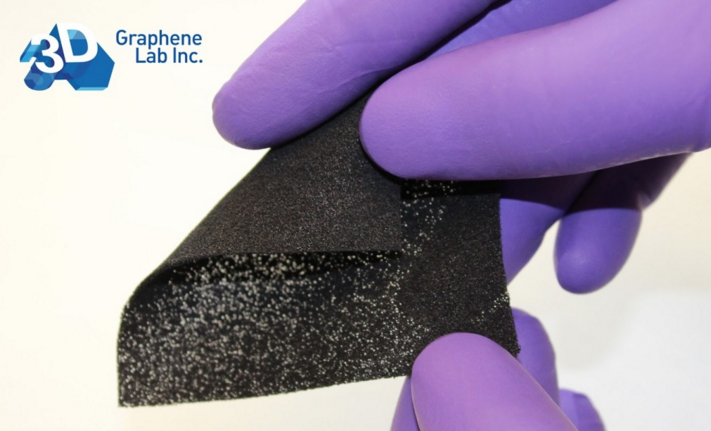 Ever the shape shifter, graphene has found a new form with which to revolutionize the design and production process of wearable electronics. We’re talking about foam, but not the kind you might be familiar with. Recently patented by Graphene 3D Lab Inc., graphene flex foam is a multilayer, freestanding three dimensional foam and elastomer composite that is super lightweight and conducive.
Ever the shape shifter, graphene has found a new form with which to revolutionize the design and production process of wearable electronics. We’re talking about foam, but not the kind you might be familiar with. Recently patented by Graphene 3D Lab Inc., graphene flex foam is a multilayer, freestanding three dimensional foam and elastomer composite that is super lightweight and conducive.
The most notable aspect of the latest graphene breakthrough is its flexibility. Elena Polyakova, Co-CEO of Graphene 3D, is confident in flex foam’s versatile applications: “Any company interested in a freestanding, stable, ultralight, highly conductive material that can flex with their product and fit into any space, will be interested in this innovation.” A highly porous structure allows the foam to flex, fold and fit into tight spaces, which is sure to have many applications in wearable technology and beyond. Here are four ways we can expect to see graphene flex foam put to use in the near future:
1. Lithium-Ion Batteries
According to Daniel Stolyarov, Co-CEO of Graphene 3D, “Graphene Flex Foam is an excellent substrate candidate in the manufacture of electrodes of lithium-ion batteries.” The main form of batteries powering a wide array of electronics including watches, lithium ion batteries have long been overdue for a powerful upgrade that flex foam can provide.
2. Wearable Electronic Sensors
Wearable electronics have only just scratched the surface of their true potential. Because smartwatches and other wearables need to be super flexible, their form has so far been dictated by the limits of less capable materials than graphene. With flex foam, we can expect to see the design process of wearable tech completely freed up. The electronics, sensors, and conductive properties that wearable tech requires will be perfectly addressed by graphene in a flexible, freestanding and stable foam form.
3. Shock Absorber for Phone Displays
Scientists at the Indian Institute of Science (IISc), Bengaluru have successfully demonstrated how graphene flex foam can be used for stronger phone displays. A miniature shock absorber made of flex foam could help keep phones and laptops from shattering.“Composed of an extremely thin layer of graphene, its density is only 0.54 grams per cubic cm, as compared to 7.87 and 2.7 gram per cubic cm of iron and aluminium respectively,” says Abha Mishra, assistant professor, Department of Applied Physics. Flex foam can also withstand more cycles of operation than traditional shock absorbers.
4. Deadly Gas Sensor
Nitrogen dioxide is one of the main causes of pollution in the atmosphere, and this same research team has discovered a way to use graphene flex foam to detect dangerous levels of the gas that could have life-saving applications. “The graphene-based sensors work on the principle that charge transfer takes place between graphene foams and adsorbed gas molecules. This changes the resistance of the foams and hence their electrical conductivity (how easily current can flow). By measuring these changes in electrical conductivity,it can be easily correlated with the levels of ambient nitrogen dioxide,” explains Abha Mishra, assistant professor, Department of Applied Physics.



